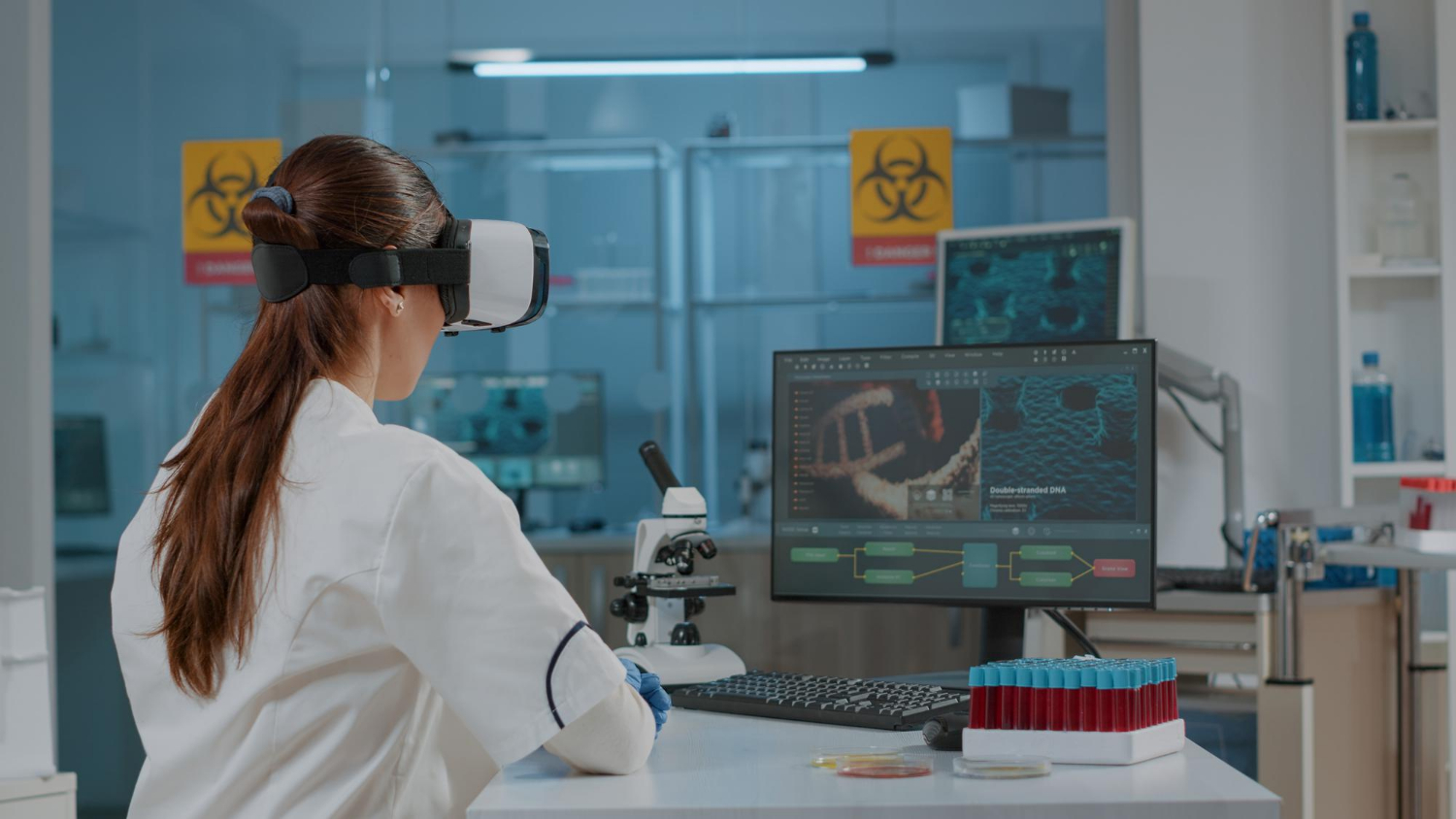Strategy and Scope
Predictive analytics now sits at the centre of pharma strategy. Leaders want faster insights and fewer blind spots. Teams need clear methods that predict future demand, risks, and clinical results. Good choices start with good questions. You set a goal, select the right data, and apply fit‑for‑purpose models. You measure lift, cost, and impact on business processes. You then improve the system with each run.
Artificial Intelligence (AI) boosts scale and accuracy. Learning algorithms process large datasets without fatigue. Data scientists design repeatable workflows that the business can trust. The aim stays simple. You reduce uncertainty and act faster than your competitors.
Types of Data Analytics in Pharma
You work with four main families. These types of data analytics serve different needs yet connect well.
Descriptive analytics shows what happened. You summarise trials, sales, and safety events. You spot shifts in adherence or site performance.
Diagnostic analytics explains why it happened. You test drivers for delays, cost spikes, and protocol breaches. You link root causes to metrics that teams can control.
Predictive analytics estimates what will happen next. You forecast enrolment, supply, and outcomes with predictive models. You combine time series data with clinical variables and market signals.
Prescriptive analytics suggests what to do. You compare options under cost and risk limits. You run scenarios and pick actions that raise value.
This mix gives end‑to‑end visibility. You move from rear‑view reporting to forward action.
Read more: AI in Pharma Quality Control and Manufacturing
Predictive Models and Core Techniques
Strong models start with clear design. Techniques include decision trees for transparent choices and splits. Regression models quantify how variables shape outcomes. Neural networks capture non‑linear signals in images, text, and sensor streams. Time series methods track seasonality and shocks. You add statistical modeling to test stability and avoid spurious effects.
You do not chase complexity for its own sake. You pick the simplest model that meets the goal. You test bias, variance, and drift. You monitor lift on real tasks, not just benchmark scores. You keep the code clean and the features explainable.
Data scientists maintain a model library. They track versions, metrics, and approvals. They document limits and triggers for retraining. Business teams join reviews and sign off on live use. Everyone knows what the system can and cannot do.
Data, Talent, and Operating Models
Great models need great data. You build robust pipelines for trials, supply, sales, and medical affairs. You curate sources and remove noise. You standardise units and terms across markets. You tag sensitive fields and set strict access controls.
Compute needs can grow fast. You plan capacity for training and scoring. You balance speed, cost, and location. Some teams deploy near the point of use. Others send jobs to central clusters during off‑peak hours.
Talent makes the system work. Data scientists build and tune models. Engineers ship stable services. Domain experts set guardrails and validate outputs. Product managers align work with goals and value. You create a rhythm of releases, reviews, and lessons learned.
Read more: Generative AI for Drug Discovery and Pharma Innovation
R&D, Trials, and Safety Use Cases
Target prioritisation and drug design
Predictive models rank targets and compounds. Teams predict future signals for efficacy and toxicity. You cut low‑yield paths early and shift funds to stronger bets. Models score candidates on tractable endpoints and safety flags.
Site selection and patient enrolment
You forecast site throughput with time series and local data. Decision trees help assign sites to each protocol. You analyse social factors and travel time. You match designs to regions that can recruit quickly and retain patients.
Dose, adherence, and protocol risk
Regression models link adherence to profile and context. You test dose ranges against outcome bands. Neural networks read visit notes and spot patterns in free text. Teams spot drift early and issue corrective actions before failures spread.
Signal detection and pharmacovigilance
You triage safety signals with rules and classifiers. You reduce false positives and focus on true risks. You pull from spontaneous reports, EHR notes, and device data. You predict future case growth and plan resources ahead of demand.

Supply, Commercial, and Finance Use Cases
Demand, inventory, and distribution
Time series models forecast orders at SKU and region level. You adjust for seasonality and event spikes. You set buffer stock with statistical modeling. You simulate shocks and test alternative flows.
Field planning and customer insight
Predictive analytics segments HCPs by interest and need. Models suggest next best actions that support patients. Teams plan calls that respect policy and local rules. You track uplift and refine the plan each cycle.
Pricing, access, and revenue
Regression models and decision trees support price bands under constraints. You forecast payer responses and budget impact. You check fairness and keep documentation tight. Finance teams align choices with long‑term value.
Fraud detection and partner risk
You scan claims and channel data for anomalies. You flag patterns that match known schemes. You test false positive rates and refine thresholds. You also score credit risk for trade partners and wholesalers. You keep goods flowing and reduce losses.
Advanced Integration Across Pharma Functions
Predictive analytics does not operate in isolation. It intersects with every major function in the pharmaceutical enterprise, creating a lattice of interdependencies that demand rigorous orchestration. When predictive models inform research and development, they simultaneously influence downstream manufacturing schedules, procurement cycles, and even commercial launch strategies. This interconnectedness amplifies both the potential benefits and the operational risks, requiring governance frameworks that extend beyond traditional silos.
Consider the implications for adaptive clinical trials. Time series forecasting combined with neural networks can dynamically recalibrate enrolment targets based on interim efficacy signals. These recalibrations cascade into supply chain adjustments, as investigational product volumes must align with revised patient cohorts. Failure to synchronise these shifts can result in either surplus inventory or catastrophic shortages, each carrying significant financial and reputational consequences. Thus, predictive analytics becomes not merely a technical capability but a strategic imperative embedded within business processes.
Complexity in Model Architecture and Interpretability
The sophistication of predictive models introduces a dual challenge: computational intensity and interpretability. Neural networks, while adept at capturing non-linear interactions, often function as opaque systems. Their decision pathways defy intuitive explanation, complicating regulatory submissions where transparency is non-negotiable. Conversely, decision trees and regression models offer clarity but may falter when confronted with high-dimensional datasets typical of genomic or multi-omics research.
Data scientists mitigate these tensions through hybrid architectures. Techniques include stacking interpretable models atop deep learning layers, thereby generating surrogate explanations without sacrificing predictive power. Statistical modelling frameworks complement these hybrids by quantifying uncertainty, enabling risk-adjusted decision-making rather than binary judgements. This layered approach demands substantial compute power and disciplined version control, underscoring the need for robust infrastructure and governance.
Read more: Scalable Image Analysis for Biotech and Pharma
Ethical Dimensions and Algorithmic Accountability
As predictive analytics permeates sensitive domains such as patient stratification and fraud detection, ethical considerations escalate. Algorithms that predict future adherence or adverse events wield profound influence over therapeutic access and resource allocation. Bias embedded in training datasets can propagate inequities, exposing organisations to both regulatory sanctions and public scrutiny.
Mitigation strategies extend beyond technical fixes. They encompass procedural safeguards such as algorithmic audits, fairness metrics, and stakeholder review boards. These mechanisms institutionalise accountability, ensuring that predictive insights augment—not undermine—clinical integrity and patient trust. Intellectual property concerns compound this complexity, particularly when proprietary learning algorithms intersect with licensed datasets. Legal teams must delineate ownership boundaries with precision to avert disputes that could derail innovation pipelines.
Strategic Outlook and Competitive Dynamics
The trajectory of predictive analytics within pharma signals a paradigm shift from reactive operations to anticipatory ecosystems. Organisations that operationalise predictive models at scale will compress cycle times across research, development, and distribution. They will pivot from static forecasting to adaptive orchestration, recalibrating strategies in near real time as market, regulatory, and clinical signals evolve.
Competitive advantage will hinge on more than algorithmic sophistication. It will derive from the agility with which firms integrate predictive insights into decision hierarchies, harmonise cross-functional workflows, and institutionalise governance. In this context, predictive analytics transcends its technical origins to become a cornerstone of enterprise resilience and strategic foresight.
Governance, Ethics, and IP Considerations
Trust builds adoption. You need strong governance and clear roles. You define data rights and retention rules. You record provenance and consent. You isolate test and live zones and prevent leakage.
You set review boards for model risk. They approve new use cases and monitor drift. They check fairness and impact on patients. You add kill switches for any tool that goes off track. You maintain model cards and audit trails.
You also protect innovation. You track how you built features. You record methods and results. Legal teams step in early when models draw on licensed data. You keep intellectual property safe while you share enough detail for compliance.
Read more: Real-Time Vision Systems for High-Performance Computing
Roadmap for Scaled Adoption
You can start small and scale fast with focus. Pick one high‑value journey. Enrolment, demand, or safety all work well. Build a thin slice that runs end‑to‑end. Ship it to a limited group. Measure lift and gather feedback. Fix the gaps and scale to more markets.
You build repeatable assets. Data contracts. Feature stores. Model templates. You create a playbook so new teams move faster. You align incentives so functions share wins. Commercial shares signals with supply. R&D shares signals with safety. Everyone gains from one truth.
People also shape success. You train users to read outputs and challenge the model. You coach teams to ask better questions. You award wins that link to patient benefit. Some groups even use the phrase pharmamachine learning in internal notes. You can use “pharma machine learning” in formal documents for clarity.
Future Outcomes and Sector Outlook
The next five years will reward teams that act now. Predictive analytics will sit inside every major decision. Trials will run with fewer delays. Sites will hit enrolment targets more often. Supply will see fewer stock‑outs and less waste. Commercial teams will plan with precision and support better care.
Models will grow more adaptive. Learning algorithms will adjust to shifts in behaviour and policy. You will predict future trends with less data and still hold accuracy. You will also combine signals from text, images, and sensors. Neural networks will enrich the feature space without bloating cost.
Data scientists will move closer to the frontline. They will sit with trial managers and plant leads. They will translate model outputs into actions that teams can own. Business processes will tighten and waste will drop. The benefits of predictive methods will reach more patients and markets.
You will not chase novelty for its own sake. You will choose the right tool for the task. Techniques include simple trees for clarity and speed. You will reserve deep stacks for problems that truly need them. You will keep documentation clean so auditors can follow each step. You will align incentives so everyone wins.
You can also apply lessons from finance. Credit risk models show strong discipline in data and review. You can adopt that discipline for distributors and large buyers. Fraud detection playbooks also transfer well. You can cut chargebacks and detect fake returns early. You then reinvest the savings in patient access.
Time series methods will improve stock planning. Better forecasts will support greener operations. Fewer urgent shipments will cut cost and emissions. Plants will plan maintenance with more confidence. Leaders will make choices with clearer trade‑offs and fewer surprises.
Read more: AI-Driven Drug Discovery: The Future of Biotech
How TechnoLynx Supports Your Journey
TechnoLynx builds predictive analytics solutions for pharma at scale. We design data pipelines, feature stores, and model services that fit your goals. Our teams deploy decision trees, regression models, neural networks, and time series systems with clear KPIs.
We run co‑development with your data scientists and domain experts. We improve speed without cutting corners. We ship models that predict future demand, safety signals, and site performance. We also build fraud detection and credit risk tools for channel partners. You get results that your teams can trust and explain.
Ready to move from pilots to scaled value? Let’s talk!













